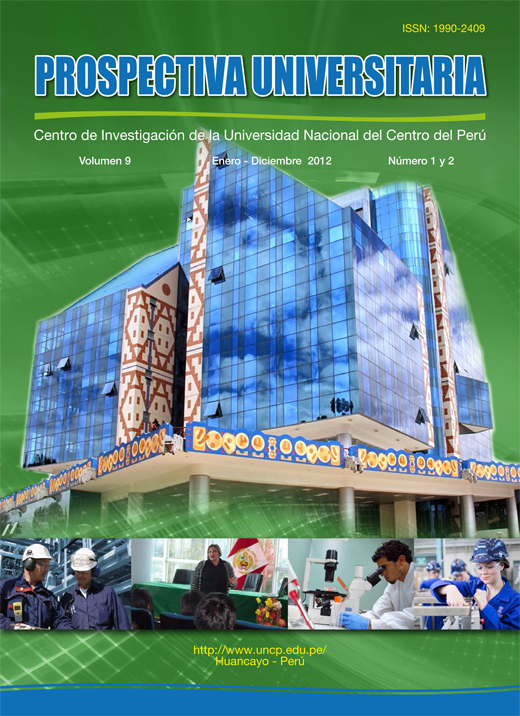Design criteria for decision making in the evaluation of mining alternatives in companies in central region of Peru
DOI:
https://doi.org/10.26490/uncp.prospectivauniversitaria.2012.9.36Keywords:
Decision Analysis multiopinion, designing, selection of the mining operationAbstract
The design of a mine has a group of processes to reach its strategic objectives and its vision among those that we can highlight: the selection of the method of minning, the geometric dimensionamiento of the mine, the determination of the annual rhythm of production and the court law, the extraction sequence, etc. Does the present investigation fix as main problem, Which are the approaches of design employees in the selection of methods of having mined in the mining companies of the central region of the Peru?; as general objective: “To determine the design approaches; for the selection of methods of having mined in the mining companies of the central region of the Peru” and I eat general hypothesis: “The design approaches used in the selection of methods of having mined in the mining companies of the central region of the Peru, are not good”. You uses the non experimental method, descriptive transeccional. The used design was descriptive simple and correlacional. Concluding that; alone 16.33%, of the mining companies fulfills the design approaches partially for the selection of methods of having mined. Consequently the hypothesis outlined in our investigation been been worth. Being these companies the following ones: Mining company San Ignacio of Morococha, unit San Vicente (Medium mining); Volcano Mining Company S.A.A. (Great mining); Mining Argentum CORP., Morococha (Medium mining). Regarding the taking of
decisions of the selected companies can conclude that alone 5%, he/she carries out a simulation and bill with a design process able to analyze alternative multicriterio. To select the method of having mined extractive optimó is one of the problems of decision multicriterio (DM) in which the decisores should assign a weight to the approaches to carry out a simulation. To solve this problem he/she thinks about the ponderación of variables by means of pesos and the selection of the method by means of the sumatoria of the same ones.
Downloads
References
Anales de congresos nacionales de Ing. de Minas “Trabajos técnicos de Ing. de Minas”. Colegio de Ingenieros del Perú. Lima Perú. 2012.
Anales de convenciones de Ing. de Minas “Trabajos técnicos de Ing. de Minas”. Instituto de Ingenieros de Minas del Perú. Lima Perú. 2012.
Azadeh, A., Osanloo, M., & Ataei, M. (2010). A new approach tomining method selection based on modifying the nicholas technique.Applied Soft Computing Journal, 10(4), 1040-1061.
Barba Romero, S., & Pomerol, J., Decisiones Multicriterio.Fundamentos Teóricos y Utilización Práctica., Universidad de Alcalá de Henares, 1997
Bitarafan, M.R., Ataei, M., 2004. Mining method selection by multiple criteria decision making tools. J. S. Afr. Inst. Min. Metall.104, 493–498.
Bogdanovic, D., Nikolic, D., & Ivana, I. (2012). Mining methodselection by integrated AHP and PROMETHEE method. Anais DaAcademia Brasileira De Ciencias, 84(1), 219-233.
Boshkov, S.H., Wright, F.D., 1973 (Basic and parametric criteria inthe selection, design and development of underground mining systems). SME Mining Engineering Handbook. SME-AIME, NewYork.
Cortés Aldana, F. A, García Melón, M., Aragonés, P., Selección de una tecnología de banda ancha para la Universidad Nacional deColombia, sede Bogotá, usando una técnica de decisión multicriterio, Revista Ingeniería e Investigación, Vol.27 No.1, 2007, pp. 132-137.
D.E. Nicholas, Selection Procedure, SME Mining Engineering Handbook, second edition, Society for Mining Engineering,Metallurgy and Exploration, Inc., 1992, pp. 2090–2106.
D.H. Laubscher, Selection of Mass UndergroundMining Methods,Design and Operation of Caving and Sublevel Stoping Mines, D.Stewart, SME-AIME, New York, 1981 (Chapter 3, pp. 23–38).
Downloads
Published
Issue
Section
License
Copyright (c) 2019 Victor Javier Mendiola Ochante

This work is licensed under a Creative Commons Attribution-NonCommercial-ShareAlike 4.0 International License.
Esta Revista es de acceso abierto a su contenido a través del Internet, poniendo a disposición de la comunidad científica los resultados de la investigación, de manera gratuita, para el intercambio del conocimiento desarrollado.
El contenidos de la Revista se distribuyen bajo la licencia Creative Commons Reconocimiento-NoComercial-CompartirIgual 4.0 Internacional.
![IconJournalPU [ENG] by Edgar Julian-Laime®](https://revistas.uncp.edu.pe/public/journals/1/pageHeaderLogoImage_en.png)









